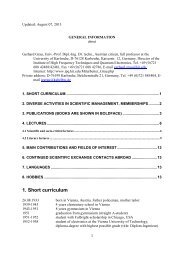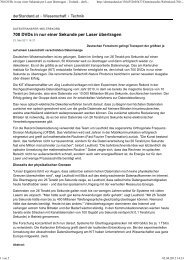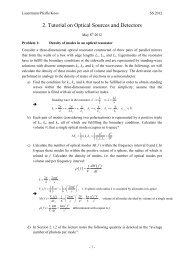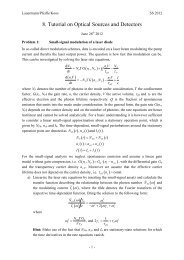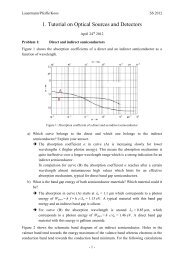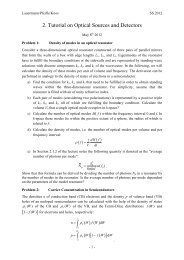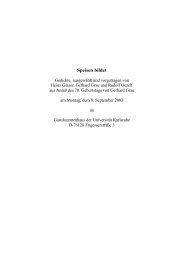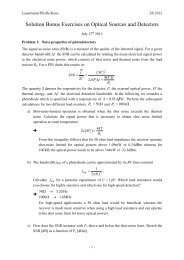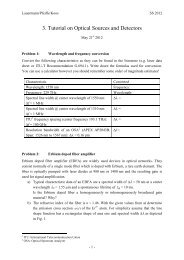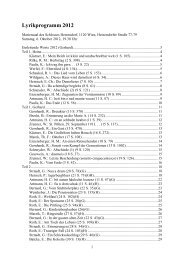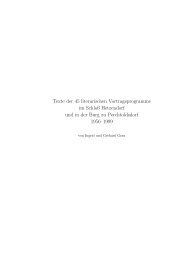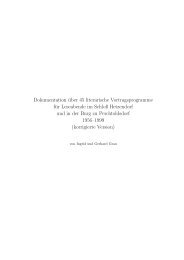Exercise 01 - IPQ - KIT
Exercise 01 - IPQ - KIT
Exercise 01 - IPQ - KIT
Create successful ePaper yourself
Turn your PDF publications into a flip-book with our unique Google optimized e-Paper software.
Lauermann/Pfeifle/Koos SS 2<strong>01</strong>2Problem 1:1. Tutorial on Optical Sources and DetectorsApril 24 rd 2<strong>01</strong>2Direct and indirect semiconductorsFigure 1 shows the absorption coefficients of a direct and an indirect semiconductor as afunction of wavelength.Figure 1: Absorption coefficient of a direct and an indirect semiconductora) Which curve belongs to the direct and which one belongs to the indirectsemiconductor? Explain your answer.b) What is the band gap energy of both semiconductor materials? Which material could itbe?Figure 2 shows the schematic band diagram of an indirect semiconductor. Holes in thevalence band tend towards the energy maximum of the valence band whereas electrons in theconduction band tend towards the conduction band minimum. For the following calculationsuse the values of silicon: Indirect band-gap energy W G = 1.13eV and lattice constanta = 0.543nm.Figure 2: Schematic band diagram of an indirect semiconductor; LB (“Leitungsband”) denotes the conductionband; VB is the valence band.- 1 -
Lauermann/Pfeifle/Koos SS 2<strong>01</strong>2c) Calculate the frequency of a photon that corresponds to the band gap energy of silicon.How large is the momentum of this photon? Compare this momentum to the crystalmomentum of the electron.d) Consider now a phonon with a momentum that corresponds to the crystal momentumof the electron. Compare the energy of the phonon to the band gap energy when youconsider a value of v s = 8433m/s for the speed of sound in silicon.e) Is it possible to build an efficient light source using silicon? Explain your answer.Problem 2:Linear and logarithmic scale conversionThe logarithmic scale is widely used in optical communication. Especially the ratio betweentwo power levels is often described in the dimensionless unit decibel (dB). Such a ratiobetween power P 1 and power P 0 is normally defined in dB as 10 ∙ log 10 (P 1 /P 0 ).a) Calculate the corresponding numbers in dB for the different power ratios ofP 1 /P 0 = 1, 2, 4, 10, 20, 100, 0.5, 0.25, 0.1b) In contrast to dB, the absolute unit dBm is used to express an absolute power. The unitdBm refers to the power P 1 referenced to 1mW and is therefore defined asP [dBm] = 10 ∙ log 10 (P 1 /1mW). Fill the following table, use the results from a) and try todo it without a calculator.100 nW8 mW25 µW10 mWBonus Program:linearlogarithmic3 dBm26 dBm-7 dBm-23 dBmAt three randomly chosen exercises we will collect your notes before the exercise starts. Theywill be marked and if you accomplish an average of 70% or more of all collected exercises,your oral examination grade will be upgraded by 0.3 or 0.4 (except grades of 1.0 and 4.7 orworse). If you cannot join an exercise, you may also hand your notes to the teaching assistants(see contact details below) before the respective exercise.Questions and Comments:Matthias LauermannJörg PfeifleBuilding: 30.10, Room: 2.32 Building: 30.10, Room: 2.23Phone: 0721/608-41695 Phone: 0721/608-48954Email: Matthias.Lauermann@kit.eduEmail: Joerg.Pfeifle@kit.edu- 2 -



